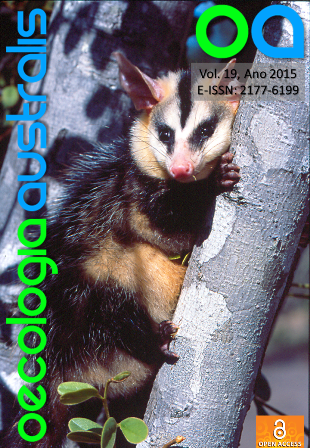NEOTROPICAL WILD CATS SUSCEPTIBILITY TO CLIMATE CHANGE
DOI:
https://doi.org/10.4257/oeco.2015.1901.05Keywords:
Species distribution modeling, Ecologic niche modeling, Biodiversity, Conservation, Felidae, South AmericaAbstract
Ongoing climate change and the human role as dominant cause behind it are undeniable and already affecting living systems around the globe. Nonetheless, the likely consequences of climate change to Neotropical biodiversity are still poorly understood. We used species distribution modeling to evaluate the likely effects of climate change to the seven species of wild cats that are endemic to the Neotropics. We gathered (and provide) 424 species occurrence records from museum collections and the literature. We run the analysis on the ModEco software, using four modeling algorithms and projected models into 2050 using data from International Panel on Climate Change's last Assessment Report, under a business-as-usual emission scenario (RCP 8.5), according to five Global Circulation Models. We used an ensemble-forecasting approach to reach a consensus scenario, including only models with AUC > 0.70 for the present climate dataset. We created ensembles using the majority rule. After this procedure, we ended with two final suitability models per species, one for the present and another for the future. Model performance varied among species and was related to species' climatic suitability area (the smaller the area, the greater the model performance), and species with the smaller ranges were predicted to lose the highest percentage of their current distribution under climate change. The projections under climate change points to important contraction of climatically suitable areas for all Neotropical felids except for L. geoffoyii. The remaining species show, in average, a 43.5% contraction of suitable areas, with L. jacobitus and L. guigna showing more than 50% contraction. Both are already threatened under IUCN and Leopardus jacobitus, found only in the higher elevations of the Andes, is of special concern because highland species are particularly susceptible to a warming climate.Downloads
Download data is not yet available.
Downloads
Additional Files
Published
2017-02-23
Issue
Section
Articles


